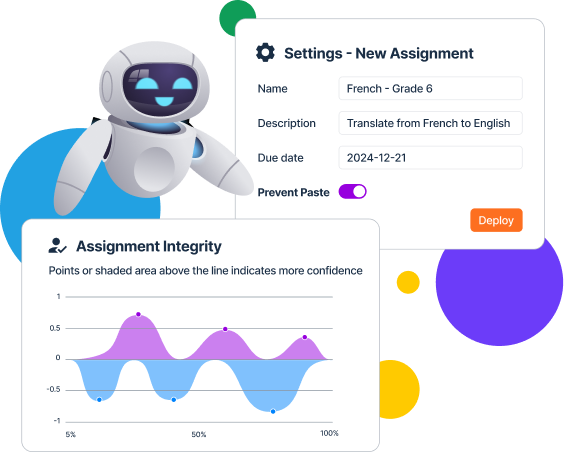Plagiarism in education is not a new issue, but the advent of digital technology has amplified the problem in significant ways. While platforms like Google Workspace for Education have revolutionized teaching and learning, they’ve also presented new avenues for academic dishonesty.
This blog aims to address these challenges and offer solutions for Google Admins responsible for upholding academic integrity.
The Changing Face of Plagiarism
The digital age has transformed the concept of plagiarism, making it easier for students to find and copy material. With just a few clicks in Google Classroom, students can readily submit work that isn’t their own. Google Admins must adapt to these evolving challenges to ensure academic honesty remains a cornerstone of educational institutions.
Role of Google Admins
For Google Admins, the job is two-fold: to employ the features within Google Workspace for pedagogical benefit while simultaneously mitigating the risk of plagiarism.
Functions such as “version history” in Google Docs can be instrumental in tracking the genesis of a student’s work, thereby providing valuable insights into its originality.
AI Technologies and Plagiarism
Artificial intelligence (AI) presents a paradox in education. While AI can streamline administrative tasks and personalize learning experiences, it can also facilitate academic dishonesty. AI-powered tools like Chat GPT can churn out essays and research papers in a fraction of the time it would take a student, posing yet another challenge for Google Admins.
The Growing Importance of Anti-Plagiarism Tools
The urgency for robust anti-plagiarism tools is more palpable than ever. According to a report, the anti-plagiarism for the education sector market is projected to grow from USD 819.5 million in 2020 to USD 2,029.4 million in 2027, at a CAGR of 13.8% between 2020 and 2027.
This exponential growth indicates not only the scale of the challenge but also the increasing emphasis educational institutions are placing on maintaining academic integrity.
Taskmaster: An In-Depth Look
To counterbalance these challenges, AI-based tools like Taskmaster are emerging. This tool allows for the close monitoring of student work, flagging content that appears to be AI-generated.
By providing a percentage score indicating the likelihood that the content is machine-generated, Taskmaster serves as an additional layer of defense against plagiarism.
But that’s not all, here’s how Taskmaster can help you fortify further academic integrity:
- Detect AI-Created Content: It employs sophisticated algorithms to differentiate between AI-generated and human-generated text. The tool scans the language structure, content complexity, and even sentence length to identify potential AI-based plagiarism.
- Block or Detect Copy-Paste Action: The ability to restrict “copy-paste” directly within the assignment not only promotes originality but also integrates seamlessly with Google Workspace, making it easier for admins to implement.
- Check Assignment Integrity: Unique identifiers like typing patterns can confirm the true authorship of a submission. This is especially useful in remote learning environments where direct supervision is limited.
- Real-time Monitoring: Teachers can track students’ writing patterns, measure engagement levels, and monitor time spent on the assignment, all in real time. This granular level of insight allows Google Admins to assess the academic integrity of student work more effectively.
Tips and Best Practices for Google Admins
Maintaining academic integrity in the age of digital education requires a multifaceted approach. Google Admins can consider the following in-depth strategies:
- Randomize Assessments: Use the features within Google Forms to randomize question order and even answer choices. This makes it difficult for students to share answers.
- Scheduled Release of Material: Use the scheduled release feature in Google Classroom to ensure that all students get access to materials and assignments at the same time, reducing the time window for potential dishonesty.
- Educator Training: Periodic training sessions for teachers can help them understand how to design fool-proof assignments and assessments. This could range from suggesting the use of open-ended questions to advocating for project-based assessments that demand original thinking.
- Student Workshops: Hosting workshops aimed at educating students about the consequences of academic dishonesty can serve as a preventive measure. It’s just as important to clearly explain what counts as plagiarism, especially online.
- Ongoing Audits: Regularly review the analytics provided by Google Workspace and tools like Taskmaster to identify any abnormal patterns that could indicate issues with academic integrity.
By employing these in-depth insights and tools, Google Admins can create a comprehensive strategy for combating plagiarism and upholding academic integrity in digital education environments.
Get Ready for the Next School Year with Google Classroom Taskmaster Tool
Conclusion
The digital age has brought forth new challenges and opportunities to combat plagiarism in education. Google Admins play an important role in maintaining academic integrity in a world increasingly facilitated by Google Workspace and influenced by AI technologies.
Tools like Taskmaster can be invaluable in this ongoing effort, offering practical, AI-driven solutions to this complex problem.
Insights That Matter. In Your Inbox.
Join our newsletter for practical tips on managing, securing, and getting the most out of Google Workspace, designed with Admins and IT teams in mind.







